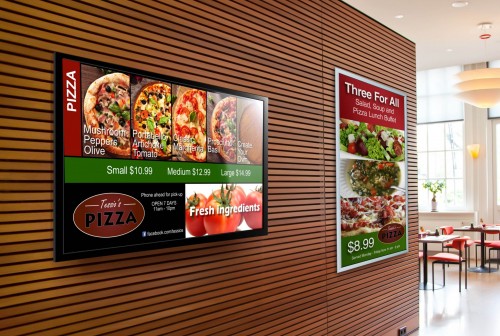By Peter Saunders
The market for digital signage is growing by all measures. In late 2013, for example, a report from analytics firm IHS predicted the global digital signage industry would increase in value—in terms of revenue for equipment, software, services and media—to $14 billion in 2014 and onward to $17.1 billion by 2017.
“Improvements in technology offerings, data management and infrastructure expansion will help the industry continue its positive momentum,” says Sanju Khatri, IHS’s director for signage and public information displays. “With ‘smart’ content and dynamic interfaces, the integration of real-time data into real-world applications will further stimulate revenue growth.”
Digital signage has had an especially major impact with retailers, who are using it to target customers more efficiently, prolong their ‘dwell’ time, improve shopping experiences and increase sales. IHS predicted the retail sector would account for 42 per cent of total digital signage display revenue for the 2013-2017 period.

Digital signage has helped retailers target customers more efficiently, prolong their ‘dwell’ time, improve shopping experiences and increase sales.
Quick-service restaurants (QSRs), too, are using digital signage to offer dynamic content and appealing visuals, particularly by replacing ‘static’ menu boards with screens. With these new digital menu boards, Khatri notes, the ability to make immediate changes is helping QSRs to promote new dishes and upsell higher-margin items. Indeed, digital menu boards have been shown to achieve an average upsell of 5.7 per cent over printed boards. They can even help reduce inventory since, as IHS digital signage analyst Kelly Lum points out, live data feeds allow managers to review sales and adjust in-store marketing messages accordingly.
Digital signage is also becoming increasingly prevalent in universities to display upcoming events, building directories, wayfinding maps and emergency messages to students and faculty.
In other words, digital signage is being used by many of the same local businesses and organizations that have traditionally been customers of sign shops. And even when these clients have not yet deployed digital signage themselves, they have probably heard of it by now and do not need a full introduction.
As such, traditional signmakers and wide-format print-service providers (PSPs) need to be familiar with it, too, and decide whether or not it is a product they want to offer themselves.
Complementary value
“The value of digital signage is in timely messaging, sales lift and the perceived reduction of wait time,” says Tim Greene, director of wide-format printing research for InfoTrends, a technology strategy and consulting firm. “If you don’t offer digital signage and your customers see your competitors rolling it out, you’re leaving the door open for other sign shops to do it for them.”
While InfoTrends focuses on the document management, digital printing and publishing sectors, Greene has also studied the digital signage industry since 2001 and has concluded it is complementary to printing, rather than posing an existential threat.
“The digital signage market is growing and sign shops are well-positioned to provide their customers with all of the benefits of this powerful and highly versatile platform,” he says. “As a product line extension, digital signage can increase revenues and profits for sign shops and provide a greater value proposition to their customers. It can even drive additional printing activity, such as feature wall and floor graphics to capture attention and bring people toward a digital sign.”






